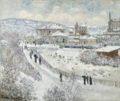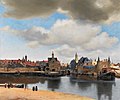Houses in Argenteuil

|
| Houses in Argenteuil |
|---|
| Claude Monet , 1873 |
| Oil on canvas |
| 54 × 73 cm |
| National Gallery, Berlin |
Houses in Argenteuil ( French Maisons d'Argenteuil ) is a painting by the French painter Claude Monet from 1873. The picture painted in oil on canvas has a height of 54 cm and a width of 73 cm. You can see asummer landscape on the edge of Argenteuil , a suburb of Paris, paintedin the style of Impressionism . The painting belongs to the collection of the National Gallery in Berlin .
Image description
The painting Houses in Argenteuil is structured on three levels. A flowering meadow occupies the lower third of the picture, in the middle the eponymous houses are lined up from the left to the right edge, the top is formed by the cloudy sky. The three areas of the picture were executed very differently by Monet. In the foreground he shows the light green meadow painted with small dots of color, in which numerous yellow flowers and some red poppies shine. In the “atmospheric sheen” of the meadow, the signature “Claude Monet” can be found at the bottom right. In contrast to the meadow, the painting in the area of the houses is outlined with clear lines. To the left and in the middle are two small, almost identical houses. The view goes straight to their gray-blue facades; a white cornice separates the ground floor and the attic. The borders of the doors and windows, which appear as black rectangular surfaces, are also white. The sides of the gables are bordered by the scarlet tiles of the gable roofs. Another house in a similar design is cut from the left edge of the picture. On the right is a larger white house that towers over the other houses by one floor. On the two lower floors, the black surfaces of the windows contrast with the white wall color, in the attic, which is covered with light red tiles, there are two dormer windows. All house roofs are provided with narrow chimneys. A small shed adjoins the building to the right.
Between the building in the middle and the white house on the right, the steeple of the Saint-Denys basilica rises into the sky some distance away . Various trees can be seen in front of and behind the row of houses. While tall trees with thick, dark foliage stand in the background, young saplings with thin trunks and recognizable individual leaves can be found in the foreground at the end of the meadow. Between these freshly planted trees and the houses, small house gardens are indicated as brown and green areas. On closer inspection there are two people in a picture that initially appears to be deserted. Monet sketched them on the right edge of the picture with a few brushstrokes while they hunched over their gardening. The "wonderfully moving sky" was brought to the canvas by Monet with virtuoso brushstrokes and coarse paint application. The color nuances range from light areas in blue on the left to more gray areas on the right. The clouds blown by the wind give the sky a lively moment, the lighting underlines the dramatic events in this otherwise rather calm landscape.
Monet at Argenteuil
Claude Monet and his family fled to London in 1870 before the Franco-Prussian War . He then moved to the Netherlands for a few months in June 1871 before returning to Paris in November of that year. At the end of 1871 he settled in Argenteuil and rented a house not far from the train station in Rue Pierre Guienne No. 2. Life here in the suburbs was cheaper than in the nearby capital and Monet found enough motifs for his pictures on the banks of the Seine. Argenteuil was considered a center of water sports that attracted the people of Paris for sailing or rowing. Corresponding leisure activities appear repeatedly in Monet's pictures. The place itself, however, is only occasionally the subject of his pictures. At the beginning of his stay in Argenteuil, he created the view The Boulevard Héloise in Argenteuil ( Yale University Art Gallery , New Haven) in 1872 , in which he shows a broad arterial road with sketchy pedestrians and a wagon. Much more intimate is the description of the domestic environment in Monet's garden in Argenteuil (Dahlias) ( National Gallery of Art , Washington DC) from 1873. In the picture, the lush flowers are in the foreground, while a pair of lovers has moved into the background at the end of the garden. Only the house on the neighboring property is a reference point to the town of Argenteuil. In the landscape painting Die Seine near Argenteuil ( Kunstmuseum Bern ) created in 1874, the location has been pushed into the background as a panorama. While the reeds in the foreground , behind it the Seine and above all the sky take up large parts of the picture, the silhouette of houses, church and some smoking factory chimneys have receded as part of the horizon line. In the winter landscape View of Argenteuil in the Snow ( Nelson-Atkins Museum of Art , Kansas City (Missouri)), painted in 1875, Argenteuil is not the actual subject of the picture. The houses shown in the view at the edge of Argenteuil with their snow-covered roofs part of a wintry mood image and not vedutenhafte description of a place. In this respect, the depiction is similar to the motif in the painting Houses in Argenteuil , although the images naturally differ in the season.
The buildings Monet painted in the picture Houses in Argenteuil had only been erected a short time before on the western edge of the town. The young trees give an indication of this, while near the church in the background an old tree population refers to the historic town center. The new buildings also reflect the rapid development of the suburb, which began in 1851 after Argenteuil was connected to the railroad. The smaller houses in the picture, built with modest means, may have been built for people from Paris who wanted to spend their free time here in the country. It was this longing for country life that brought Monet to Argenteuil. The desire to leave big city life behind has repeatedly been picked up by contemporary cartoonists and writers. A well-known example of this is the satirical novel Bouvard and Pécuchet by Gustave Flaubert .
reception
The Berlin museum director Hugo von Tschudi noted in 1898 that Monet succeeded with this painting "creating an apparently unattractive motif through the liveliness of the treatment, the delicacy of the color moods, the magic of the air reproduction." More than a decade later, the art critic Karl condensed it Scheffler made this statement: “The motif is almost banal; but it is ennobled by the way it is presented. ”He continued:“ You don't even think of oil paint anymore, you smell nature, so to speak ”. In 2000, the art historian Paul Hayes Tucker compared Monet's picture Houses in Argenteuil with landscape paintings from the Dutch Baroque . In Monet's Argenteuil view he saw a modern vision of paintings such as Die Pleichen bei Haarlem by Jacob van Ruisdael ( Kunsthaus Zürich ) or View of Delft by Johannes Vermeer ( Mauritshuis , The Hague).
Provenance
Claude Monet sold the painting Houses in Argenteuil before 1880 to the art dealer Paul Durand-Ruel , in whose portfolio it remained for around two decades. He loaned the picture to the International Art Exhibition in Dresden in 1897 , where the Berlin museum director Hugo von Tschudi saw it. Tschudi asked Durand-Ruel about the price of the picture in October 1897, but initially it was not purchased. Tschudi may have seen the picture again when it was exhibited in the 1898 anniversary art exhibition in Vienna in the spring of 1898 . On December 19, 1898, he finally acquired the picture from Durand-Ruel for the National Gallery in Berlin. Henriette Mankiewicz , the founder, took over the purchase price of 5,500 francs . The art historian Babette Warncke attributed Tschudi's hesitant purchase of Monet's painting to “increasing hostility to his purchase policy”. The picture Houses in Argenteuil was on a list of other works of art in 1899, including by Hans von Marées and Paul Signac , which Tschudi submitted for the approval of the Minister of Education, Robert Bosse . The value for Monet's painting was given as around 3,000 marks , an amount that did not require the personal approval of Kaiser Wilhelm II .
literature
- Cooperative of Visual Artists Vienna (ed.): Jubilee art exhibition 1898 . Catalog for the exhibition in the Künstlerhaus and in the Musikverein building, Verlag der Genossenschaft der Bildenden Künstler Wien, Vienna 1898.
- Johann Georg Prinz von Hohenzollern , Peter-Klaus Schuster (ed.): Manet to van Gogh, Hugo von Tschudi and the struggle for modernity . Exhibition catalog Nationalgalerie Berlin and Neue Pinakothek, Munich 1996, ISBN 3-7913-1748-2 .
- International Art Exhibition (Ed.): Official catalog of the International Art Exhibition Dresden 1897 . Arnold, Dresden 1897.
- Peter Krieger : Painter of Impressionism from the National Gallery Berlin . Mann, Berlin 1967.
- Karl Scheffler : The National Gallery in Berlin, a critical leader . Cassirer, Berlin 1912.
- Paul Hayes Tucker : The Impressionists at Argenteuil . Yale University Press, New Haven 2000, ISBN 0-300-08349-1 .
- Angelika Wesenberg (ed.): Painting in the 19th century: the collection of the National Gallery . Vol. 2, L – Z, Michael Imhof Verlag, Petersberg 2017, ISBN 978-3-7319-0458-8 .
- Daniel Wildenstein : Monet, Catalog raisonné - catalog raisonné . Wildenstein Institute and Taschen Verlag, Cologne 1996, ISBN 3-8228-8759-5 .
Web links
Individual evidence
- ↑ The German title Houses in Argenteuil is given in Daniel Wildenstein: Monet, Catalog raisonné - Werkverzeichnis , vol. 2, p. 118.
- ^ The French title Maisons d'Argenteuil is given in Daniel Wildenstein: Monet, Catalog raisonné - Werkverzeichnis , vol. 2, p. 118.
- ↑ a b Peter Krieger: Painter of Impressionism , p. 13.
- ↑ a b c d e f Paul Hayes Tucker: The Impressionists at Argenteuil , p. 104.
- ↑ a b c d e f Babette Warncke: Claude Monet: Houses in Argenteuil in Johann Georg Prinz von Hohenzollern, Peter-Klaus Schuster: Manet bis van Gogh, Hugo von Tschudi and the struggle for modernity , p. 94.
- ^ Daniel Wildenstein: Monet, Catalog raisonné - catalog raisonné , vol. 2, p. 118.
- ^ A b c Karl Scheffler: Die Nationalgalerie zu Berlin, a critical leader , p. 241.
- ^ A b Daniel Wildenstein: Monet, Catalog raisonné - Werkverzeichnis , Vol. 2, p. 119.
- ↑ Quote from Hugo von Tschudi's report on the acquisition of Monet's houses in Argenteuil to the Minister of Education Robert Bosse from 1898, kept in Berlin, SMPK, Zentralarchiv, Gen. 37, BD. VI, reproduced in Babette Warncke Claude Monet: Houses in Argenteuil in Johann Georg Prinz von Hohenzollern, Peter-Klaus Schuster: Manet bis van Gogh, Hugo von Tschudi and the struggle for modernity , p. 94.
- ↑ Referred to as Argenteuil in the official catalog of the International Art Exhibition Dresden 1897 , No. 410, p. 36.
- ↑ Designated as Argenteuil in the cooperative of visual artists Vienna: Jubilee art exhibition 1898 , No. 664, p. 117.
- ↑ Angelika Wesenberg: Painting in the 19th century: the collection of the National Gallery . Vol. 2, L-Z, p. 626.





